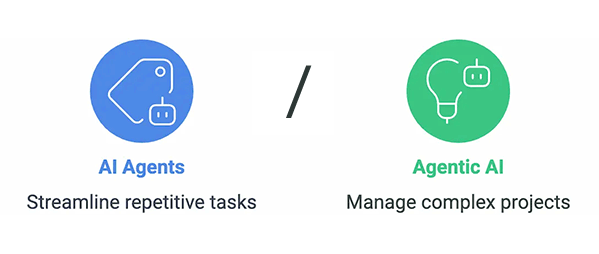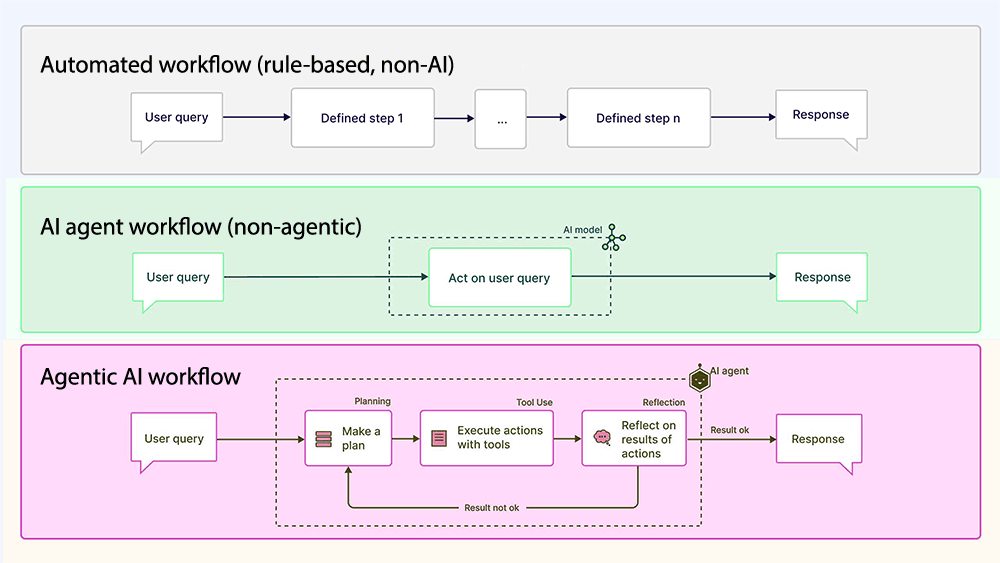In every era, a breakthrough technology emerges that redefines the boundaries of what humans can achieve.
Artificial intelligence is rapidly evolving, and terms like 'AI agents' and 'agentic AI' often come up together. While they may sound similar, their capabilities and implications for society couldn't be more different.
Broadly speaking, both involve AI systems that can make decisions and act, but they differ in scope and autonomy. In simple terms, AI agents are individual tools or programs designed to accomplish specific tasks on command, whereas agentic AI refers to larger systems of collaborating agents that set their own goals and work autonomously to solve complex problems.
These two AIs in modern industries have profound implications, not just technologically, but culturally and economically.
With these two paradigm, no longer are we simply asking: what can AI do for us? Instead, we should be asking: what should AI do—on its own?

AI Agents, The Helper
An AI agent is essentially a software “helper” built to perform defined tasks. According to IBM, an AI agent is “a system or program that is capable of autonomously performing tasks on behalf of a user or another system by designing its workflow and utilizing available tools."
In practice, an AI agent might use machine learning and natural language processing to handle one part of a process.
For example, one agent might sort email or answer customer queries, another might schedule meetings or generate text, and yet another might analyze simple data trends. These agents work within a limited domain and follow rules or patterns they’ve been trained on – for instance, a smart thermostat adjusts temperature based on conditions, or a calendar bot books appointments on cue.
They typically react to specific requests or triggers without overarching objectives of their own.
In other words, AI agents can be trained to understand their environment, process information, and take actions to achieve specific goals," but each agent usually focuses on a single task.
Key characteristics of AI agents include:
- They operate within predefined frameworks.
- They rely on the tasks they’re explicitly given.
- They often use rule-based logic or trained models to respond.
Common examples include chatbots in customer service (answering routine questions automatically), email assistants that sort or suggest replies, and even coding helpers like GitHub Copilot that suggest code snippets as developers type.
OpenAI's ChatGPT is considered one of these AI agents.
Because these agents are trained to master specific tasks, they can be very efficient at repetitive or well-defined jobs. However, each AI agent by itself does not set its own goals; it simply follows instructions (or learned patterns) to complete its task.
To go beyond that, the agents need to work together to form a system, called an Agentic AI.

Agentic AI, A Goal-Driven System
Agentic AI refers to AI systems that are much more autonomous and goal-driven.
Instead of being a single tool, agentic AI is a system of agents working together under a common objective. As one IBM source puts it, "agentic AI is the broader concept of solving issues with limited supervision, whereas an AI agent is a specific component within that system."
In other words, agentic AI is the "architecture" or framework that coordinates multiple AI agents to achieve big-picture goals.
AI agents has its limits, typically because its an ANI, and cannot handle tasks outside its design. While it can learn from lots of things from its data set, it usually can’t reason about the broader context or manage unfamiliar situations on its own.
If an agent encounters an unexpected problem or if its task changes slightly, it may fail or need human reprogramming.
Agentic AIs have four attributes:
- They make autonomous decisions.
- They pursue long-term goals by planning multi-step strategies.
- They learn and adapt from experience.
- They use advanced reasoning to solve complex problems.
In practical terms, an agentic AI can monitor its environment, break down a large objective into subtasks, assign those subtasks to specialized agents (or AI modules), and then coordinate their actions while learning what works.
Unlike a single chatbot or calendar bot, agentic AI is designed to be proactive and self-directed, adjusting its plan in real time as conditions change.
It not only can respond to one command at the time; agentic AI can manage complex, open-ended driving tasks, simultaneously.
One good example of an agentic AI, is Tesla’s Full Self-Driving system, which can continuously perceives the road, makes navigation decisions, and learns from experience.

Key differences between an AI agent and an agentic AI include autonomy, scope and proactiveness.
Whereas the scope and structure of AI agents are single-purpose components, agentic AI is more of a coordinated system of agents. An AI agent might handle one step (like responding to an email), but an agentic AI system can orchestrate many agents to complete an entire workflow (like processing a customer support case from start to finish)
As for autonomy, individual AI agents, no matter how smart they are, can only act within predefined bounds. They respond to inputs but don’t set their own objectives. Agentic AI takes this autonomy further. It can set goals, plan multiple steps ahead, and change course without constant human prompts
For example, an AI agent might execute a password reset when asked, whereas an agentic AI could notice a pattern of many resets, diagnose a root cause, and then take independent action to fix it (such as patching a bug)
Then, there is the difference between their decision-making capabilities. Whereas AI agents generally make simple decisions based on learned patterns or rules, agentic AI can evaluate many options, weigh trade-offs, and choose actions that align with a broad strategy
In fact, agentic AI can even set intermediate sub-goals toward a long-term objective, much like a project manager assigning tasks.
As for their adaptability and learning, an AI agent improves mainly through retraining or software updates. Agentic AI systems on the other hand, learn continuously from new data and outcomes, adapting their approach over time.
This allows them to handle dynamic situations.
For instance, while an AI agent chatbot might improve slowly as it’s fed more customer dialogs, an agentic customer-support AI could learn on the fly to redirect overflow tickets or escalate unusual cases without being reprogrammed.
And lastly, AI agents tend to be reactive – they wait for instructions or triggers. Agentic AI can be proactive. It can anticipate needs and take the initiative. For example, instead of just answering questions, an agentic system might preemptively suggest optimizations or flag issues (e.g. it could detect a network vulnerability and fix it before an attack occurs)
Agentic AI can go further than an AI agent, despite still considered an ANI.
However, these systems are complex and resource-intensive. They often rely on ensembles of large models and require robust tool integrations and data access, which can be hard to set up. Because they can make decisions on their own, there’s a risk of unintended outcomes – they might pursue a goal in an unexpected way, or misinterpret instructions in edge cases.
Long story short, an AI agent is like a skilled worker who follows orders; agentic AI is more like a full team with a manager who identifies goals and directs the team’s activities.

The Future Of The AI-Driven World
AI agents and agentic AI are steadily transforming many industries, with more and more companies planning, and already deploying AI agents and agentic AI.
In practice, this can all be attributed to their smart automation, which could elevate burdening and repetitive tasks, freeing users more time to focus on the goal rather than the process.
While AI agents and agentic AI represent different ends of the automation spectrum, but together they are reshaping the very fabric of work and culture.
As AI matures, the line between task automation and autonomous decision-making continues to blur, prompting society to reimagine the nature of work, creativity, and organizational structure.
